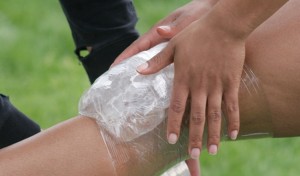By John C. Kagan, M.D. –


Meniscus Tear & Treatment Options
Twisting or pivoting the knee while the leg is bent can tear the meniscus, a wedge of cartilage that covers the ends of the upper and lower leg. The meniscus acts as cushion or shock absorber between the two bones.
In younger people, a traumatic injury related to sports can damage the meniscus, while in older adults, it is usually related to a degenerative aging process. When you tear the cartilage in your knee, it is typically the meniscus that is torn.
If nonsurgical methods fail to bring relief, an orthopedic surgeon can repair the tear during arthroscopic surgery. Untreated, the tear can interfere with any movement that requires bending the knee, such as climbing stairs, getting in and out of chairs or a car, and even walking. Some people may also say the knee feels like it is locking or catching because a torn piece of cartilage is interfering with the normal function of the joint.
During arthroscopic surgery, the surgeon first removes any fragments of cartilage and then repairs the tissue by sewing or fastening the torn edges together. After the procedure is completed, the knee is wrapped and immobilized for several weeks. Physical therapy will help strengthen the joint to regain full motion.
ACL Tear & Treatment Options
The anterior cruciate ligament is one of four major ligaments in the knee. It connects the top of the lower leg to the bottom of the thigh bone. Sports such as soccer, tennis, basketball and snow skiing sometimes require a rapid change of direction or a hard landing from a jump. This can tear the ACL ligament. Overextending the knee is another contributing factor to an ACL tear.
If surgical treatment is required, the torn ACL is not sewn back together. Instead, during arthroscopic surgery, the surgeon clears away the damaged tissue and replaces it with a “new” ligament The graft can come from the patient’s own body by taking a piece of patellar (kneecap) ligament, or using a tendon from the hamstring or quadriceps. Or it can be an allograft from a donor.
The American Academy of Orthopedic Surgeons reports that surgical reconstruction of the ACL has a 82 percent to 95 percent long-term success rate. Similar to recovery for a meniscus tear, patients who under ACL repair will need physical therapy to return to full strength following surgery.
For more information about knee injuries or other orthopedic-related concerns, please call John Kagan, M.D., at 239-936-6778 or visit www.kaganortho.com.
 Southwest Florida's Health and Wellness Magazine Health and Wellness Articles
Southwest Florida's Health and Wellness Magazine Health and Wellness Articles

